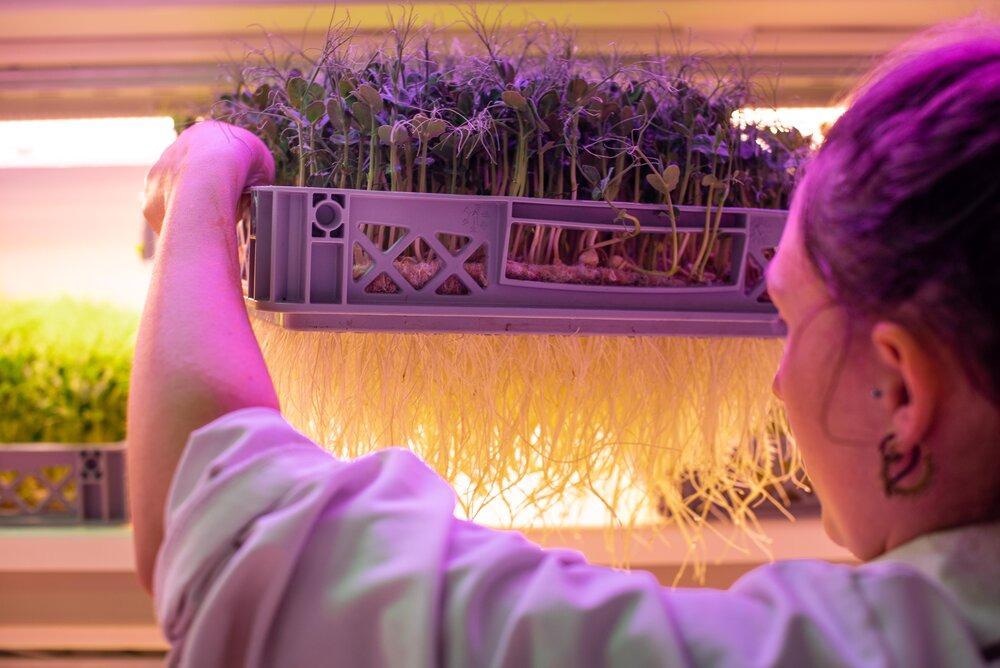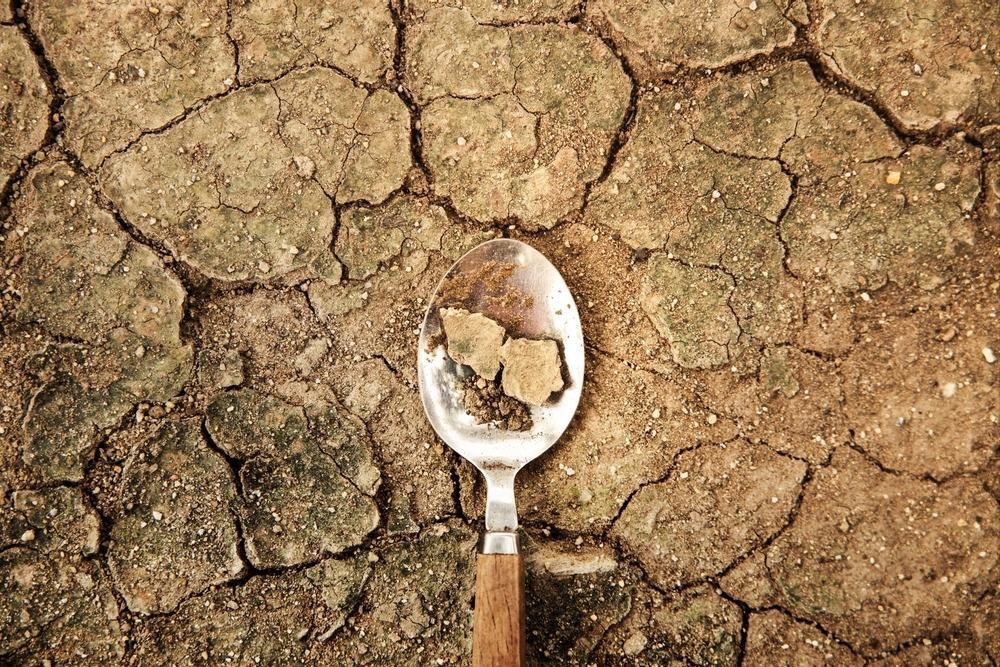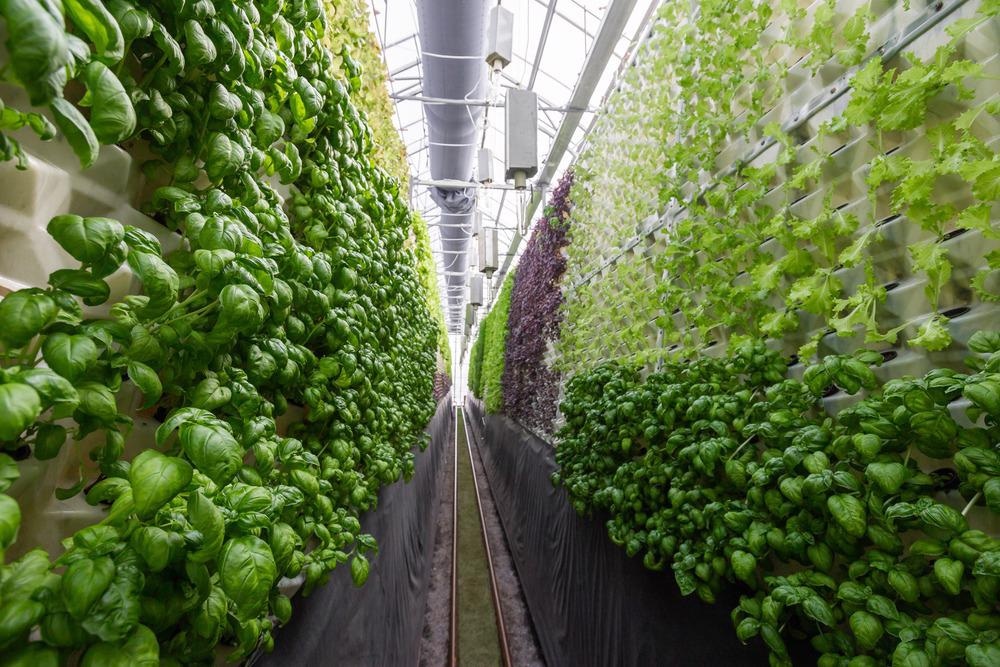Is vertical farming and aeroponics the future of sustainable farming? We spoke to India from LettUs Grow to find out and learn more about their innovative agricultural technology and how it is helping to reduce waste and the carbon footprint of fresh produce.
Please can you introduce yourself and tell us about your role at LettUs Grow?
I'm India, and I am the Food Systems Research and PR Lead at LettUs Grow. As far as I know, it's a pretty unique role (I've never seen it advertised anywhere else), which shows what a profoundly thoughtful organization LettUs Grow is.
My role is a 50/50 split between learning and communicating. I spend around half my time researching and thinking about the food system we're working within. The other half feeds that information back into the business or creates content for our audiences about the many complexities of how food goes from farm to fork. I've worked in food sustainability communication for over seven years, and outside of LettUs Grow, I'm also a postgraduate at the Center for Food Policy in London.
At LettUs Grow, you are focused on designing and building aeroponic technology and farm management software for vertical farms. Can you tell us more about why LettUs Grow was founded and what some of your aims and missions are?
Since day one, our mission has been the same; "to reduce the waste and carbon footprint of fresh produce by empowering anyone, anywhere, to grow food near its point of consumption." But the scale of what we mean by this and how we achieve it has grown over time.
The spark for LettUs Grow was a news article about how much salad was wasted in UK supply chains and homes and the environmental impacts of that waste. That piece of journalism hit home hard for our three founders (Charlie, Ben, and Jack), two engineering master's students, and a recent plant-biology graduate working in the university's innovation center. They knew things needed to change and decided to put their combined skills to work in reducing the waste and carbon footprint of fresh produce.
After working "in the field", the team realized that salad waste was just the tip of the iceberg for food sustainability. They saw how far-reaching the problems in our food system are. They couldn't be addressed solely by consumer-focussed interventions. Growing indoors and at scale, in everything from greenhouses to vertical and container farms, was going to be vital in creating positive change.
Over the years, they and an ever-growing team of specialists developed our patent-pending technology to create aeroponic farms that can bring resilience to our food supply networks and will be crucial to the future of sustainable farming. Our very first product, a small aeroponic grow-at-home kit, has now transformed into a 40ft container farm and beyond.

Image Credit: LettUs Grow
Vertical farming is an innovative, sustainable way to increase crop production without causing further damage to our planet. Can you tell us more about vertical farming and how it works?
Vertical farming is the practice of growing crops in vertically stacked layers, much like a bunk bed or multi-story car park. It's very space and resource-efficient and allows you to grow in places that would otherwise be off-limits. It fits into a broader category of farming called controlled environment agriculture or CEA.
CEA is a catch-all name for methods of growing crops indoors while controlling elements of the environment such as irrigation, temperature, humidity, or light. The term includes greenhouses, plant factories, vertical farms, and container farms. It protects against disease, pests, poor weather, and challenging climatic conditions. There are three main methods of vertical farming: hydroponics, aquaponics, and aeroponics.
Hydroponic
Hydroponics is a method of growing plants without soil. Instead, the plant's roots hang down into nutrient-rich water. Plants grown hydroponically have been shown to grow faster than those grown in soil. Hydroponics can be used in both greenhouses, making use of sunlight, or in vertical farms, under LED lighting.
Aquaponic
Aquaponics is, in essence, a form of hydroponics, but instead of dissolving nutrients in water, you use the wastewater from aquaculture. Excretions from aquatic animals accumulate in the water. This effluent-rich water is then fed into a hydroponic system where the by-products are broken down into nitrates that the plants then absorb as nutrients. The cleaned water is then recirculated back to the aquaculture system.
Aeroponic
Aeroponics is similar to hydroponics, but instead of the roots hanging down into a nutrient solution, they hang down into a nutrient-dense mist. Since the roots are suspended in air, this mimics the air pockets found in a healthy soil system and boosts access to oxygen.
At LettUsGrow, you offer a range of technologies, including your DROP & GROW container farm and your Ostara software. Can you tell us more about some of your solutions, how they work, and their advantages?
LettUs Grow at heart is an aeroponic technology company. This alternative growing method allows plant roots to grow healthier and faster than in hydroponics, which is the most common irrigation system used in greenhouses and vertical farms. Aeroponics typically uses nozzles and pressurized water to generate mist. However, technical complexities and issues with this intricate equipment have held back adoption within wider agricultural applications such as greenhouses.
We have developed a unique "no-pressure" aeroponic system that overcomes some of the challenges of large-scale aeroponic deployment, meaning it can be used for much higher production volumes. In in-house trials, we have found that this method can grow some crops up to twice as fast as in comparable hydroponic systems while using 30% less water.
Ostara is the LettUs Grow farm management platform. It enables growers to remotely manage and monitor the growing environment of their greenhouse or vertical farm via a mobiledevice or tablet. Ostara bridges the gap between a farm management platform and farm control software. Combining these into one program allows users to fine-tune the operations of their farm. Users can monitor the farm as a whole or zoom in on the details - so no leaf goes unchecked.
Benefits of Ostara:
- Minimize labor costs by spending less time on routine tasks and reduce the need for extra hands around the farm.
- Ostara helps catch problems early. If something unexpected happens or anything goes wrong, Ostara will let you know.
- Ostara gives you access to expert advice. Through Ostara, you can give our team of specialists permission to view your system remotely, meaning they can help diagnose problems and provide solutions.
- Ostara enables you to remotely manage and monitor the growing environment of your indoor farm via your mobile device or tablet.
- Efficiently manage a team and schedule your tasks. Ostara can forecast critical points in a crop's lifecycle, such as germination and harvest times, based on its sowing date and crop recipe.
- Ostara knows which bed contains which crops and then adjusts Lighting Irrigation Fertigation and Environment (L.I.F.E) cycles. These recipes are continually developed in-house by our team of expert plant scientists.
- Reduce operation costs by using Ostara to adjust the day-night cycles to when energy is cheapest.
DROP & GROW is essentially a farm-in-a-box. It's a full vertical farming system fit into a bright pink 40ft shipping container. It is the only aeroponic container farm on the market in the UK.
Inside we've combined our powerful aeroponic technology with our software platform, Ostara, which together can double the growth rate of plants compared to a hydroponic system.
Benefits of DROP & GROW:
- Grows up to twice as fast as industry-standard hydroponics.
- You don't need growing experience to get started because you'll have access to crop recipes that our team of expert growers has optimized.
- It uses less water than both outdoor growing & hydroponics.
- It uses less fertilizer & prevents runoff into waterways.
- It uses no pesticides or harmful chemicals.
- Growing closer to the consumer reduces food miles & waste.
- Vertical farming grows more in less space, taking pressure off our soils & degraded farmlands.
- It is transportable and can be placed close to the point of distribution.
- Since it is classified as a temporary structure, you typically don't need planning permission.
How does your technology not only help to improve the environmental impact of agriculture but also make farmers' lives easier and more profitable too?
What motivated us to get into the sector was mitigating the impacts of fresh produce on our planet. Because the farming industry is just so vast (half of the world's habitable land and 70% of fresh water is used for agriculture) and needs to feed so many people, it runs into some pretty big problems including; deforestation & habitat destruction from creating new farmland, terrestrial & freshwater ecotoxicity from pesticides and other agrochemicals, freshwater depletion, and eutrophication from fertilizers runoff.
Controlled environment agriculture can help mitigate these impacts by reducing the number of resources (water, land, fertilizer, and other agrochemicals) needed to produce our food and isolating intensive practices away from nature. A DROP & GROW, for example, will use 95% less water and fertilizer than an outdoor farm and zero pesticides.
However, while all of this is associated with farming, farmers themselves get a tough break. They're being squeezed from every possible angle. They have some 7.7 billion mouths to feed (not to mention the 17% of food that's wasted) in an increasingly unstable climate. They are expected to produce very cheap and high-quality food despite rising input costs and shortages of skilled labor. All this, while often being blamed disproportionally for the systemic problems associated with our food system.
We knew if our solution was to be effective, it had to be good for farmers too! Controlled environment agriculture can help address many of the issues faced by the people working so hard to feed us all. It can hugely increase production without increasing land, freshwater, or fertilizer use, the cost of fertilizer alone has risen 300% in 6-months.
Our aeroponic technology allows crops to grow up to twice as fast as hydroponic systems while using 30% less water than hydroponics and 95% less fertilizer than outdoor farming. Because crops are grown indoors, farmers are protected from crop/profit losses due to extreme weather, the severity of which has tripled over the last five decades in Europe, or pests. CEA also allows growers to stabilize production all year. Because the harvesting season never ends, growers will receive consistent income and projections, allowing them to plan for the future.
Currently, there are many challenges within food systems as millions of people worldwide still do not have access to healthy food. How do you believe technologies such as yours will help allow people anywhere to grow their own healthy food? What impact will this have on populations globally?
The keyword you've used here is "healthy." It's something that is all too often left out of conversations about food security, which typically have a laser-like focus on total calories. This is short-sighted when you consider the changing nature of malnutrition, with rising hidden hunger and obesity rates. Rather than a narrow focus on securing and increasing calories, technologies like controlled environment agriculture can focus on protecting and growing fruit and vegetable production. Fruits and vegetables are much higher in the micronutrients (vitamins and minerals) that people need to thrive. Unlike cereals & grains, fresh produce often has a relatively short shelf life and is often more susceptible to damage in transport, leading to losses.
CEA allows countries to nationalize the growing of fresh produce both at the large scale, in the case of big commercial greenhouses, and at the local level with technologies like container farms. It can open up opportunities to grow produce that would otherwise not be viable outside, especially at extreme latitudes, and allows for protected production all year round regardless of the weather, helping to make nutritious food more available.

Image Credit: Black Salmon/Shutterstock.com
Climate change has detrimental effects on our planet, and much attention is being drawn to discovering new sustainable solutions. How does your technology at LettUs Grow help tackle the problems associated with climate change?
There are two main reasons for growing indoors when it comes to climate change: adaptation and mitigation.
Adaptation
Our climate is already changing, and there is little we can do to undo the damage that has already been done. Once-in-a-hundred-year weather events are now happening so often that the term is now basically redundant. Because our environment is becoming more unpredictable and hostile, making it difficult for farmers to adapt, we need solutions for food growing independent of the changing climate and more extreme weather, and that's exactly what controlled environment agriculture does.
Mitigation
The other side of the coin is mitigation. When done correctly and (crucially) running off renewable energy, indoor farming dramatically cuts the carbon emissions (as well as many other sustainability metrics) of fresh produce. None of this is to say we'll be growing all our food indoors, but it will certainly be part of the toolbox. Understanding and mitigating the impacts of fresh produce is something we're motivated to understand as deeply as we can, and we currently have a paper in peer-review exploring this topic in depth.
Many processes we now see as commonplace within agriculture came about due to innovation and thinking outside of the box. How important do you believe innovation is to the agricultural sector and how important is it to LettUs Grow?
I think there is a need to look both forward and backward when it comes to sustainable farming. There are remarkable technologies, like controlled environment agriculture, that can help reduce the impacts of growing certain crops. However, we mustn't lose sight of the beneficial traditional methods we have too. Many regenerative farming practices, like crop rotation or enhancing ecosystem services, are really ancient. We've been using them for thousands of years, and it was moving away from some of these practices during the Green Revolution that caused many of the problems we're trying to fix today.
At LettUs Grow, we strongly believe in careful innovation in agriculture. Just because we're a tech company doesn't mean we're here to move fast and break things, nor innovate for the sake of it. We think innovation has a crucial role to play in a sustainable future for farming, but it's also not the whole picture.
With continued technological advancements in agriculture, what do you hope the future of farming will look like? Are there any particular areas you are excited about?
We're hoping for a patchwork of different technologies and techniques in the future of farming. There is no "one-size-fits-all" answer to agriculture, and various systems complement and balance each other out. Take organic farming and controlled environment agriculture as an example. They're often pitted against each other, but they're actually an excellent pairing looking to achieve the same goals.
Organic farming is much gentler on the land that it's being grown on than conventional farming, helping to sequester carbon in the soil and foster greater levels of biodiversity. However, it takes up much more space than conventional farming, meaning we couldn't switch all our farmland to organic methods without increasing deforestation. Whereas controlled environment agriculture hugely increases productivity for certain crops, using fewer resources, on a very small footprint, and doesn't need to be situated on fertile land.
By combining the two, we can bring intensive farming indoors, relieve pressure on agricultural land, and free up space to farm more gently outdoors without expanding the amount of land used for farming.

Image Credit: Rostov Oleksandr/Shutterstock.com
What's next for LettUsGrow? Are you involved in any exciting upcoming projects?
We have been viewed as a vertical farming company only for a long time, but we're starting to take some big steps in the greenhouse space. Through 2021 we ran greenhouse trials with Harper Adams university and commercial greenhouse growers, La Serra. In June, we'll be announcing a really exciting new project at Greentech in the Netherlands, so watch this space…
Where can readers find more information?
www.lettusgrow.com
About India Langley
India is a sustainability communicator who specialises in food and farming. Since 2018, she’s headed up the PR team at LettUs Grow, an innovative indoor farming company building the farms of the future.
With ten years experience across communications, education and outreach, she’s worked on projects that reach people around the world from documentaries with Joanna Lumley to representation at COP26 and the UN Food Systems Summit Dialogues. In 2019, she was part of the Take a Bite Out of Climate Change team at the Royal Society Summer Science Exhibition teaching the public about the role food plays in climate change.
In addition to her communication, education and outreach work, she is a postgraduate at the Centre for Food Policy and was also one of the founding members of Homefarm, an app that teaches people how to grow their own produce sustainably at home.